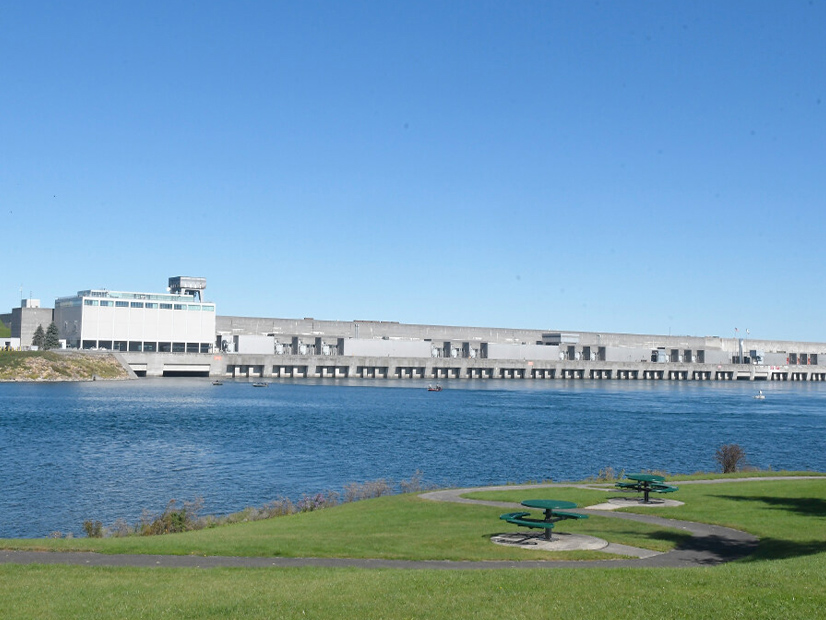
New York Gov. Kathy Hochul is proposing a significant expansion of the role of the nation’s largest state-owned utility.
In her budget presentation Wednesday, Hochul called for legislative authorization for the New York Power Authority to develop, own and operate renewable energy projects, and to provide bill credits from those projects to residents of disadvantaged communities.
The governor’s proposal would also require NYPA to propose a plan to phase out its small-scale gas-fired peaker plants by 2035, except when needed to support emergency services or reliability. And NYPA would also be able to fund training programs for prospective workers in the renewable energy field.
The proposal would not, however, compel NYPA to plan, design, develop, finance, construct, own, operate, maintain or improve renewable generation. It would merely allow NYPA to do so, alone or in partnership.
The concept Hochul is proposing is not new: A similar measure, the New York State Build Public Renewables Act (BPRA), was approved by the New York State Senate in 2022 but never advanced to a vote in the State Assembly.
Initial reaction to her proposal was underwhelming Wednesday, with some dubbing it “BPRA Lite.”
Public Power NY criticized it for omitting some of the more progressive aspects of the BPRA, such as its provisions for union labor and a just transition, and for pushing back the 2030 peaker retirement it stipulated.
“Furthermore, the governor’s proposal omits nearly all of the democratization elements found in BPRA,” Public Power NY said in a news release. “NYPA’s resources must be used to build as much renewable energy as it takes to protect our climate and safeguard our future, especially for disadvantaged communities on the frontlines of pollution and the climate crisis. This means ensuring a true mandate for NYPA to actually build renewables when the state is falling behind, not just reviewing our lack of progress.”
Gavin Donohue, president of the Independent Power Producers of New York, said he needs to further analyze the proposal, but on its face, it seems unnecessary.
The private sector is capable and willing to develop renewable power in New York, he said. “NYPA is not in a position to be more effective in building these projects.”
The Alliance for Clean Energy New York, which advocates for rapid adoption of renewables and represents companies in that sector, said it is opposed to the plan for several reasons, most of them boiling down to its focus. Executive Director Anne Reynolds said would do nothing to address the transmission constraints, onerous permitting process, non-standardized taxation and slow, expensive interconnection process that slow down renewable energy construction in New York.
“A better approach,” she said, “would be to harness NYPA’s resources and expertise to invest in the transmission system to unbottle opportunities to site wind and solar energy projects and open up new areas for projects, in addition to making other improvements to the investment landscape in New York.”
But as Public Power NY noted in its news release, Hochul’s proposal may be only an initial draft.
The executive budget proposed early in the year by the governor is one of the opening moves in New York’s budget process. Private negotiations between the governor and top legislative leaders; backroom lobbying by stakeholders; and campaigns to public popular support for (or opposition to) various provisions follow.
At the end of closed-door negotiations, near the April 1 start of the state’s fiscal year, the budget that emerges is different from the governor’s executive proposal, sometimes significantly. It is rushed through a vote in the two houses by the two leaders who negotiated it with the governor. Policy matters and other non-spending measures are sometimes wrapped into the budget measure to ensure quick passage.
In her memorandum of support for the NYPA proposal, Hochul said it is a necessary part of her budget plan because it will assist the state in meeting its goals under the Climate Leadership and Community Protection Act, the roadmap for the state’s clean energy transition.
Also in Hochul’s executive budget is an extension of NYPA’s authority to procure and sell power. It would extend the sunset date of Public Authorities Law from June 30, 2024, to June 30, 2044. Again, she writes, doing this will help the state meet its climate goals.
With 16 generating facilities and more than 1,400 circuit miles of transmission lines, NYPA calls itself the nation’s largest state power organization. The American Public Power Association ranks NYPA as the nation’s largest public power system by net generation as of 2020, narrowly higher than Arizona’s Salt River Project, and second-highest behind SRP by megawatt-hour sales.


